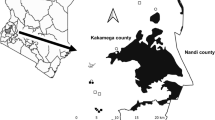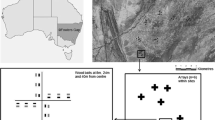Abstract
Field experiments were conducted to investigate the attractiveness of fish bones to predatory ants in a maize agroecosystem. The fish bones were applied crushed in shallow furrows together with dry maize stalks, or broadcast on the soil surface at 3 application rates: 0, 40 and 80 kg/ha; subsequent reduction in termite attack on maize plants was then assessed. Burying the fish bone powder caused higher ant nesting (102–78 %) than surface broadcasting (122–39 %). Attractiveness of the fish bones and the predatory efficiency of the ants against termites in maize was also highest with a dose of 80 kg/ha (1.0 kg/plot) causing higher nesting of ants (>90 %) and 54 % lower termite damage to maize plants compared to control plots. Dose responses indicated significant relationships between amount of fish bone powder applied and termite activity and also between termite damage and maize yield. The mechanism by which the ants are able to protect maize against termite damage may be twofold: direct kill as a result of their predatory action and termite avoidance of maize plants with ant nests. Further studies are required to assess the potential benefits of an integrated use of this technique with other non-chemical options for termite control in maize, such as intercropping.
Résumé
Des expérimentations de terrain ont été réalisées afin d’évaluer l’attractivité d’arêtes de poisson sur des fourmis prédatrices dans un agro-écosystème de maïs. Les arêtes broyées ont été appliquées enfouies dans le sol avec des débris secs de maïs ou dispersées à la surface du sol à 3 doses: 0, 40 et 80 kg/ha et on a estimé la réduction des attaques de termites sur les plants de maïs suite à ces traitements. L’enfouissement de la poudre d’arêtes a provoqué une plus grande nidification des fourmis (102–78%) que l’épandage à la surface du sol (122–39%). L’attractivité des arêtes et l’efficacité prédatrice des fourmis contre les termites dans les champs de maïs sont également plus importantes à la dose de 80 kg/ha (1,0 kg/parcelle); la nidification des fourmis est plus élevée (> 90%) et les dégâts provoqués par les termites sur le maïs sont réduits de 54%. L’effet dose réponse indique une relation significative entre la quantité de poudre d’arêtes appliquée et l’activité des termites ainsi qu’entre les dégâts des termites et la production du maïs. Le mécanisme par lequel les fourmis sont capables de protéger le maïs contre les attaques de termites serait double: une mort directe par leur action prédatrice et le fait que les termites évitent des plants de maïs hébergeant des nids de fourmis. Des études complémentaires sont nécessaires pour évaluer les bénéfices potentiels de l’intégration de cette technique avec d’autres méthodes non-chimiques pour le contrôle des termites dans les champs de maïs, telle que l’association culturale.
Similar content being viewed by others
References
Anonymous (1998) Evaluation of Fipronil 35G for control of termites in maize. Unpublished Report.
Bigger M. (1966) The biology and control of termites damaging field crops in Tanganyika. Bull. Entomol. Res. 56, 417–444.
Cowie R. H. and Wood T. G. (1989) Damage to crops, forestry and range-land by fungus-growing termites (Termitidae: Macrotermitinae) in Ethiopia. Sociobiology 15, 139–153.
Logan J. W. M., Cowie R. H. and Wood T. G. (1990) Termite (Isoptera) control in agriculture and forestry by nonchemical methods: A review. Bull. Entomol. Res. 80, 309–330.
Ochiel G. R. S. (1995) Biology and bio-control potential of Cordycepioideus bisporus Stifler and Paecilomyces fiimusoroseus (Wize) Brown and Smith on the higher termite Macrotermes subhyalinus Rambur in Kenya. PhD Dissertation, Royal Veterinary and Agricultural University, Copenhagen, Denmark. 210 pp.
SAS Institute (1990) SAS/STAT User’s Guide, Version 6, 4th Edition, Vol. 2. SAS Institute, Cary, NC.
Sekamatte M. B. (2000) Options for integrated management of termites (Isoptera: Termitidae) in smallholder maize-based cropping systems in Uganda. PhD Thesis, Makerere University. 269 pp.
Sekamatte M. B., Ogenga-Latigo M. W. and Russell-Smith A. (1999) The effect of plant architecture of open-pollinated and hybrid varieties of maize on their attractiveness to ant predators of termites. MUARIK Bulletin 2, 71–77.
Sekamatte M. B., Ogenga-Latigo M. W. and Russell-Smith A. (2000) Observations on field parasitism of the subterranean termite Pseudacanthotermes sp. (Termitidae: Macrotermitidae) by Megaselia scaralis (Diptera: Phoridae) in Uganda. MUARIK Bulletin 3, 43–48.
Sekamatte M. B., Ogenga-Latigo M. W. and Russell-Smith A. (2001a) The effect of maize stover used as mulch on termite damage to maize and activity of predatory ants. Afr. Crop Sci. 9, 411–419.
Sekamatte M. B., Ogenga-Latigo M. W. and Russell-Smith A. (2001b) The potential of proteineous and sugar-based baits in attracting predatory ants and suppressing termite damage in maize. Crop Protection 20, 653–662.
Sekamatte M. B., Ogenga-Latigo M. W. and Russell-Smith A. (2002) Estimating yield losses of maize due to termite damage in Uganda. Crop Protection. (In press).
United Nations (1987) Consolidated List of Products Where Consumption and/or Sale Have Been Banned, Withdrawn, Severely Restricted Or Not Approved By Governments. United Nations (United Nations Publ. ST/ESA/192). New York.
Wightman J. A. (1991) Soil insect problem in African groundnut crops, pp. 171–176. In Advances in Management and Conservation of Soil Fauna (Edited by G. K. Veeresh, D. Rajagopal and C. A. Viraktamath). Oxford & IBH Publ., New Delhi.
Wood T. G., Johnson R. A. and Ohiagu C. E. (1980) Termite damage and crop loss studies in Nigeria—A review of termite (Isoptera) damage to maize and estimation of damage and loss in yield and termites (Microtermes) abundance at Mokwa. Trop. Pest Manage. 26, 241–253.
Author information
Authors and Affiliations
Corresponding authors
Additional information
Deceased.
Rights and permissions
About this article
Cite this article
Sekamatte, M.B., Kyamanywa, S., Willson, H.R. et al. Effect of Placement Method and Rate of Application of Crushed Fish Bones on the Activity of Predatory Ants and Impact on Termite Damage to Maize. Int J Trop Insect Sci 22, 199–204 (2002). https://doi.org/10.1017/S1742758400012054
Accepted:
Published:
Issue Date:
DOI: https://doi.org/10.1017/S1742758400012054




